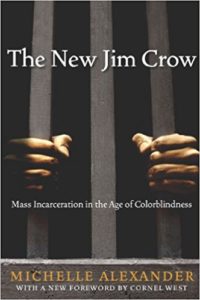
Are you aware that the highest incidence of the use and sale of illegal drugs is found in communities characterized as White? That the percentage of federal prisoners convicted of violent crimes is 7.9%? That the greatest increase in funding for the War on Drugs took place during the Administration of Bill Clinton?
Estimated reading time: 5 minutes
If you can honestly say you knew all this, go to the head of the class. If you’re like me, however, chances are you found at least one or two of these facts to be surprising — despite think of yourself as generally well informed, as I do. And if you now read Michelle Alexander‘s groundbreaking book, The New Jim Crow, you’ll come across a never-ending list of surprises about the so-called “War on Drugs” and our country’s vaunted criminal justice system.
In this extraordinary book, Prof. Alexander explains how the country’s criminal justice system has been warped to the point of nonrecognition by a series of Presidential actions, Congressional legislation, and Supreme Court decisions; how the system of arrests, prosecution, conviction, and sentencing really works now; and the catastrophic consequences of this sequence of events for our cities, our African-American and Latino communities, and ultimately all of ourselves. The New Jim Crow is one of the most important books published in the English language in a great many years, because it dispels so many of our cherished illusions and takes no prisoners in naming those responsible or in proposing remedies.
The New Jim Crow: Mass Incarceration in the Age of Colorblindness by Michelle Alexander (2010) 338 pages ★★★★★
For starters, “The United States now has the highest rate of incarceration in the world, dwarfing the rates of nearly every developed country, even surpassing those in highly repressive regimes like Russia, China, and Iran.” The number of prisoners of African-American and Latino descent is wildly out of proportion to their share of the general population, and the War on Drugs accounts for the lion’s share of the difference. Despite the fact that the incidence of drug use and drug sales are about the same among whites as they are among people of color, “In some states, black men have been admitted to prison on drug charges at rates twenty to fifty times greater than those of white men.”
Alexander demonstrates, step by careful step, how this happened, starting in 1982 with Ronald Reagan’s announcement of the War on Drugs. First, legislation proposed and passed by the same politicians (Democrats as well as Republicans) who opposed the civil rights movement) elevated drug offenses far above their previous levels — beginning three years before the introduction of crack cocaine and a nationwide increase in drug use.
Next, state and local police have been granted significant financial incentives to arrest large numbers of drug users (not, as TV and film presentations might suggest, “drug kingpins”) and insulated from charges of racism in targeting drug use in inner cities rather than in neighborhoods largely populated by whites. Prosecutors as well as police have been given free rein by a series of Supreme Court decisions to operate as they will, in the absence of any legal representation for the accused, and to justify their actions (such as excluding blacks or Latinos from juries or overcharging to force plea-bargain confessions) using even completely absurd or “silly” reasons. (Don’t believe this? Read the book!)
Imposing the harshest possible sentences for minor crimes
“Almost no one ever goes to trial. Nearly all criminal cases are resolved through plea bargaining.” Those few who do go on trial frequently face all-white juries and sentencing rules hemmed in by federal legislation that requires judges to impose the harshest possible sentences — even a life sentence for a first-time offense!
Simply possessing modest amounts of marijuana has turned millions of Americans into felons serving years in federal penitentiaries, barred for life from voting or serving on juries, shamed by their families, forced to pay fees for their own parole or probation (including drug tests), excluded from public housing, and discriminated against by most employers. Is it any wonder so many return to prison?
Alexander’s thesis is brutally simple: “Like Jim Crow (and slavery), mass incarceration operates as a tightly networked system of laws, policies, customs, and institutions that operate collectively to ensure the subordinate status of a group defined largely by race.” And we all pay the price.
For additional reading
You’ll find this book on The 40 best books of the decade.
This is also one of the many Good books about racism reviewed on this site and of 6 books that explore our broken criminal justice system.
Like to read books about politics and current affairs? Check out Top 10 nonfiction books about politics (plus dozens of runners-up).
If you enjoy reading nonfiction in general, you might also enjoy:
- Science explained in 10 excellent popular books
- Great biographies I’ve reviewed: my 10 favorites
- My 10 favorite books about business history
Enjoy reading nonfiction? Here is my list of The 10 most memorable nonfiction books of the decade.
You may also care to browse through 100 good nonfiction books about history.
And you can always find my most popular reviews, and the most recent ones, on the Home Page.




























The Atlanta community will have an opportunity to hear Michelle Alexander speak on Social Justice and Domestic Policy on Tuesday, April 9 at 11:30 AM at the MLK International Chapel, Morehouse College. For more info, go to http://www.mlkchapel.org. Yes, this is a blatant promotion, but to not promote Dr. Alexander would be a crime unto itself….
I haven’t read Alexander’s book yet, but if your analysis of this thesis is any indication – he’s spot on. No matter your opinion on drugs is, the real problem is addiction. So many people just don’t understand that addicted drug “criminals” are not just going to stop using because they face prison time. I was reading this article, which is by a rehab clinic no less
http://recoveryfirst.org/join-recovery-first-on-the-war-on-drugs.html/
Even they’re against the drug war. It’s crazy how we’re arresting people and then never giving them the treatment they need to actually stay off the streets.
I’m glad you pointed out that Clinton – a Democrat – increased funding for the War on Drugs so much. And that’s nothing against Dems in particular. It just shows that neither party is displaying any real leadership in making real changes in this issue. The few politicians who do suggest ending the Drug War (Paul, Johnson, Kucinich, etc.) are always marginalized and made to look like moonbats.
The New Jim Crow: One of the most important books published in English so far this century | Mal Warwick's Blog on Books Pretty nice post. I just stumbled upon your weblog and wished to say that I’ve truly enjoyed surfing around your blog posts. After all I’ll be subscribing to your feed and I hope you write again soon!
A drug charge can and will honestly ruin some one’s life. A drug charge will prevent someone from getting a job – no matter how qualified they are. 7 out of 10 employers now perform criminal background checks on all new employee hires. Mcdonalds and other fast food restaurants background check. A person with a drug charge is also disqualified from receiving food stamps. So, one drug arrest can keep a person from getting a job or using any government safety net programs (food stamps /public housing). Talk about the deck being stacked against you
In the last 20 yrs there has been a gigantic ‘no tolerance’ police policy toward everything. Years ago a 16 or 17 yr old kid would do something stupid and the police would tell their parents and give them a warning. Now, there aren’t any warnings. Now the police charge 16 / 17 yr olds as adult offenders, which means they will have a permanent criminal record that will follow them the rest of their lives. Mercy and forgiveness are becoming almost non existent in America.